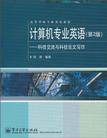计算机专业英语
出版时间:2010-9 出版社:电子工业出版社 作者:侯进 页数:264
Tag标签:无
前言
一本实用的书往往会成为你工作学习中的“好参谋”、“好助手”。在当前网络化、全球化的信息时代,人们学习英语、学习计算机与网络技术的热情空前高涨。特别是计算机及相关专业的本科生、研究生,他们既希望能熟练地阅读英文文献,也希望能用地道的英语发表论文向国外刊物投稿,为今后走出国门,用英语参与国际学术交流和宣读论文做好充分的准备。本书的作者侯进博士,长期留学国外并从事多项合作科学研究,对如何学好、用好专业英语有切身的心得体会。回国后,她为计算机、自动化等专业的本科生和研究生主讲专业英语课程,在计算机和英语两方面都有丰富的实际经验和高深的学术造诣。她性格开朗,工作热情,在本书中结合自己的成功经历,用生动的英语和明快的笔调,告诉读者如何用英语在网上检索资料、撰写论文、向国外权威刊物投稿,如何获取签证,在国际学术会议上用英语宣读论文。书中还为读者准备了一些有趣的学科前沿性内容,如GIS、Avatar等。读者只要浏览一下本书的目录,或者阅读一下自己感兴趣的某些章节,就一定会为本书的内容新颖、语句流畅、生动易学、简洁实用等特色所吸引。Practice Makes Perfect!要想学好用好专业英语尤其需要这样。衷心希望读者能通过本书的学习,在提高英语听、说、读、写能力以及开拓计算机技术和国际学术交流方面都能取得新的成功!
内容概要
本书结合作者长期在国外使用英语从事研究的经验,旨在培养读者把英文作为工作语言,提高读者专业英语的运用能力。本书分为3部分,主要内容包括:如何用英语做研究报告,英文科技论文和毕业论文的写作规范及技巧,如何参加国际会议和用英文演讲,如何向国际期刊投稿,如何检索文献及怎样选择研究课题等;介绍计算机专业前沿课题动向,以及学术研究新成果、新方法、新技术,并附相关学术论文;提供长期在国外的专家学者的建议和经验,帮助他们逐步提高独立创新工作的能力。本书每节后附词汇表、习题和相关附录,并提供电子课件。 本书可作为高等学校计算机和信息类专业研究生和高年级本科生的专业英语教材,也可供使用英语从事科研工作的科技人员学习参考。
书籍目录
Part 1 METHODOLOGIES & SKILLSChapter 1 How to Make a Research Presentation 1.1 When Do We Need to Make a Presentation? 1.2 The Structure of a Presentation 1.3 Sample 1.4 Pay Attention 1.5 Practical Tricks Exercises Appendix I Appendix II Appendix IIIChapter 2 How to Write a Scientific Paper 2.1 The Clear Structure of a Scientific Paper 2.2 Abstract 2.3 Introduction and Conclusion1 2.4 Main Body of a Paper 2.5 Reference 2.6 Useful Tricks Exercises Appendix I Appendix IIChapter 3 How to Write a Ph.D. Master Thesis 3.1 The Common Structure of a Thesis 3.2 Cover Page 3.3 Abstract 3.4 Acknowledgements 3.5 Table of Contents and List of FiguresTables 3.6Chapters 3.7 List of Publications 3.8 Bibliography Exercises Appendix I Appendix IIChapter 4 How to Attend an International Conference 4.1 Purpose 4.2 Call for Paper (CFP) 4.3 Write and Submit a Paper to an International Conference 4.4 Notification of Acceptance 4.5 Apply for a Visa 4.6 Present a Paper Exercises Appendix Appendix IIChapter 5 How to Submit a Paper to a Top JournalTransaction 5.1 Prepare and Submit 5.2 Submission Confirmation 5.3 Paper Decision 5.4 Reviewer s Comments 5.5 Revise and Submit the Final Paper Exercises Appendix I Appendix IIChapter 6 How to Search for Information on the Internet 6.1 Search Sites 6.2 Full Text Access 6.3 Database Index4 Exercises Appendix I Appendix IIChapter 7 How to Select a Research Subject 7.1 Follow Your Interest 7.2 Attend to New Theory or Technology 7.3 Think Independently 7.4 Search Literature Extensively 7.5 Interdisciplinary Research Provides New Opportunity Exercises AppendixPart 2 NEW TECHNOLOGIESChapter 8 Geographic Information System (GIS) 8.1 What is GIS? 8.2 GIS Technology 8.3 Feature of GIS 8.4 The Future of GIS Exercises AppendixChapter 9 Communication by Avatars 9.1 What is Avatar? 9.2 Purpose 9.3 Technology 9.4 Challenges and Emerging Trends 9.5 Summary Exercises AppendixChapter 1 Natural Language Processing 1.1 What is Natural Language Processing (NLP)? 1.2 Difficulties 1.3 Major Tasks in NLP 1.4 Evaluation of Natural Language Processing6 Exercises AppendixChapter 11 Content-based Image Retrieval 11.1 What is Content-based Image Retrieval? 11.2 Content Comparison Techniques 11.3 Semantic Image Retrieva 11.4 New Media 11.5 Future Directions Exercises AppendixChapter 12 Molecular Dynamics Simulation 12.1 Molecular Dynamics (MD) 12.2 Areas of Application 12.3 Molecular Dynamics Algorithm-Parallel Computing 12.4 Major Software for MD Simulations 12.5 The Aims of Molecular Dynamics Simulation Exercises AppendixChapter 13 OpenGL Technology 13.1 What is OpenGL (Open Graphics Library) Technology? 13.2 Design 13.3 OpenGL Exercises AppendixChapter 14 Distance Learning 14.1 What is Distance Learning? 14.2 Electronic Learning 14.3 Virtual Learning Environment (VLE) Exercises AppendixChapter 15 Semantic Web 15.1 Definition 15.2 Purpose 15.3 Skeptical Reactions 15.4 Components Exercises AppendixChapter 16 Ontology 16.1 Definition 16.2 Components of Ontologies 16.3 Elements 16.4 Ontology Languages Exercises AppendixPart 3 ADVICES & EXAMPLESChapter 17 Ten Rules for a Successful Presentation 17.1 Use the Same Language of the Listener 17.2 Keep SMART 17.3 Plan and Schedule Your Presentation 17.4 Keep It Short and Simple (KISS) 17.5 Make Your Audience Active Instead of Reactive 17.6 Structure Your Thinking and Make It Visible 17.7 Don t Let the Listener Lose His Way 17.8 Use Stimulus 17.9 Use Pictures 17.1 Make the Start Attractive and the End MemorableChapter 18 Promoting International Science and Technology Collaboration 18.1 Introduction 18.2 Studying in Japan as a Foreign Student 18.3 Research Culture in Japan 18.4 Japanese Research Style 18.5 Establishing a Joint Research During a Visiting Stay in Switzerland 18.6 Practical Information on Conducting Research in Japan 18.7 Practical Information on Studying in Japan4附录A 参考译文 第1部分 方法和技巧 第1章 如何做研究报告 第2章 如何写科技论文 第3章 如何写博士硕士论文 第4章 如何参加国际会议 第5章 怎样向顶级期刊学报投稿 第6章 怎样上网检索信息 第7章 怎样选择研究课题 第2部分 前沿技术 第8章 地理信息系统 第9章 借助虚拟人交流 第1章 自然语言处理 第11章 基于内容的图像检索 第12章 分子动力学模拟 第13章 OpenGL技术 第14章 远程学习 第15章 语义网 第16章 本体论 第3部分 建议和榜样 第17章 成功演讲的十大准则 第18章 推进国际科学与技术合作附录B 参考论文附录C 英文论文写作自查表附录D 学位论文写作自查表附录E 总单词表附录F Suggested Answers for Discussion参考文献
章节摘录
插图:After the acknowledgments should be the various tables of contents, denoting the pagenumbers on which the reader may find every section, subsection, subsubsection, figure, table,appendix, footnote, and semicolon in the thesis.Next comes the first thesis chapter, the introduction, which is judged on the basis of how farback in the past you start. Although the introduction is supposed to enable someone with noknowledge of your field to read and understand your thesis, this is an impossible goal. Instead,simply reference sources such as Rontgen (1896), Galileo (1610), Aristotle (-350), or othersimilarly ancient researchers. The idea to get across is that your work, being based on the work ofgreat scientists of the past, must be truly worthwhile. Even though these works have little to do withyour research, your committee isn't going to look up the references.After the introduction come chapters that describe what you did, where you did it, when youdid it, why you did it, and how much more work has to be done before you can obtain defmitiveresults. This last point is usually discussed in the concluding chapter.
编辑推荐
《计算机专业英语(第2版):科技交流与科技论文写作》:高等学校专业英语教材。
图书封面
图书标签Tags
无
评论、评分、阅读与下载
用户评论 (总计7条)
- 很好很好,发货也快,书的内容比较偏理论性
- 看着还可以,希望看完对以后能有些帮助。
- 想买来帮忙写英语论文的,但绝对可能作用不大
- 买来当教材用的,不过老师讲的时候用到的比较少,而且讲课的时候也没按上面的顺序,不过自我感觉书还可以,讲的内容是学计算机的以后都有可能用到的
- 学习专业英语的必备书
- 前天才收到货,不得不说下物流,太慢了,发了快一个星期。不过书真的挺好……
- 老师推荐的但是还没开始看,从外观来看质量不错,而且送的挺快的
相关图书
- 计算机网络技术项目教程
- 武则天
- 水处理剂配方
- 大学计算机应用基础
- 计算机基础及应用
- 计算机应用基础教程
- 大学计算机基础
- 计算机应用基础
- 大学计算机基础
- 2011证劵业从业资格考试
- 2011 银行业从业资格考试 讲义 真题 预测三合一 公共基础
- 电子技术基础与技能
- 我是最美高考满分作文
- 人性的弱点全集
- 2011 银行业从业资格考试 讲义 真题 预测三合一 风险管理
- 2011 银行业从业资格考试 讲义 真题 预测三合一 个人贷款
- 2011 银行业从业资格考试 讲义 真题 预测三合一 公司信贷
- 电路基础
- 微生物工程
- 瓦尔登湖
- 现代通信技术概论
- MPLS和VPN体系结构(第2卷)
- 风险的社会放大
- 基因表达式编程算法原理与应用
- 中文印刷体文档识别技术
